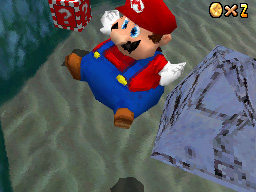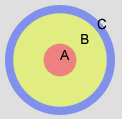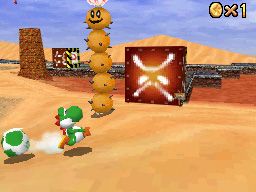|
 |
 |
 |
|
|
Super Mario 64 DS
Developer: Nintendo
Publisher: Nintendo
Number of Players: 1-4
Memory: 3 slots
Touch Controls: Yes
Wi-fi Compatible: No
Release Date: 11/21/04
|
|
|
 |
 |
|
|

 |
 |
 |
Storyline
Upon receiving an invitation from Princess Peach, Mario, with brother Luigi and nemesis Wario tagging along, head to the Mushroom Kingdom castle for a taste of the princess's assumed tasty cake. As Lakitu watches the three capped heroes casually enter the castle with empty stomachs, an unnerving feeling began to strike the three guests.
Meanwhile, on the castle rooftop, a peaceful Yoshi naps...but not for too long. Lakitu, having noticed that Mario, Luigi and Wario have been in the castle for far too long, wakes the snoozing Yoshi and asks him for help in the investigation.
As Yoshi makes his entrance to the now-mysterious castle, he soon learns from a Toad that Bowser, the renown, evil King of Koopas, has taken and hidden the castle's power stars. As if isn't bad enough news for the Mushroom Kingdom, Yoshi's told that Bowser has also trapped Peach and her three hungry invitees within the castle walls and paintings.
Given no other choice, Yoshi and his newly-found cameraman Lakitu set out to save the day...
|
|
 |
 |
|
|
 |
 |
 |
Gameplay
Main Adventure
This pure 3D platformer takes place in a castle that acts as the game's central hub. Although the paintings on the walls might seem as if they're meant for eye candy, they're actually used to travel to the different courses in the game, of which there are 15. In addition to these main courses are other levels to play through, most of which are significantly smaller in comparison.
The main goal in the game is to collect the power stars that Bowser has hidden throughout castle grounds and its inner courses. There's a total of 150 stars to collect. Each of the 15 main levels contain 8 stars that can each be acquired by completing various tasks. For example, players might be asked to race against a character, collect five silver stars in order to have a power star appear, or even get their cap back from a treacherous little monkey. Boss battles, though not very numerous, are also present throughout the adventure.
Although only one character, Yoshi, is playable at the beginning of the game, eventually players will be able to choose from four different ones (Mario, Luigi and Wario being the other three). Each character has his own array of moves, some of which are required to acquire certain stars. What this entails is that players will sometimes need to switch to a different character if they wish to complete the game. In every level are caps that are capable of transforming a character into another, meaning that players aren't required to exit a level in order to switch characters. Of course, the need to switch to Yoshi does require exiting the level, as Yoshi does not have an associated cap.
Each character has his own special moves. Using an item from a red block when playing as Mario, for example, allows Mario to fly or float upwards in balloon fashion. When playing as Luigi, he becomes semi-invisible and can walk through fences and enemies. Wario's special allows him to become hard as metal, which allows him to not be blown away by strong gusts of wind, and also makes him heavy enough sink to the bottom of a water-filled area. Yoshi can swallow enemies whole and make eggs out of them. The eggs can be used to shoot at other enemies.

As Mario uses the special item, he is able to pump some air and float upwards for a limited time
Super Mario 64 DS offers three types of control styles.
In Standard Mode, moving your character is done by pressing the directions on the D-Pad, which limits players to pressing eight different directions to move around. The face buttons on the right and the L/R shoulder buttons are used for actions such as running, jumping, crouching, and more. A few buttons located on the touch screen are used to move the camera.
Touch Mode is used in conjunction with the thumb strap that is included with every Nintendo DS system. The thumb strap is actually used to simulate an analog control stick, a feature lacking from the DS system. Players are able to strap the item around their thumb and move it across the screen to direct the character. The face buttons are again used for actions, but this time are also for rotating the camera view around a character.
Finally, Dual-Hand Mode allows players to use the stylus to direct the movement of the character. The face buttons are all action buttons for left-handed players. Right-handed players aren't left out, however. The control pad on the left of the system is equally used for such actions. For you ambidextrous individuals...this may very well be the toughest decision you'll ever make!
 When the touch screen is touched, a three-layered circle appears. The character remains motionless as the red portion in the center (A) is pressed. As the player slides the stylus away from the center in any direction, it enters the yellow portion of the circle (B), which makes the character walk at different speeds depending on how far from the center the stylus is. When the stylus reaches the third, thin layer of blue (C), the character starts to run. When the touch screen is touched, a three-layered circle appears. The character remains motionless as the red portion in the center (A) is pressed. As the player slides the stylus away from the center in any direction, it enters the yellow portion of the circle (B), which makes the character walk at different speeds depending on how far from the center the stylus is. When the stylus reaches the third, thin layer of blue (C), the character starts to run.
Mini-Games
There are 36 mini-games in total. Eight of them are unlocked at the start, and unlocking the rest is a question of catching bunnies that are spread about the central hub (the castle). The bunnies run away from the player on a pre-defined track. Oddly enough, sometimes the bunnies actually chase the player instead of the opposite thanks to this pre-definition...
All 36 of the mini-games make use of the touch screen, but not all of them use both screens. That's not to say that the unused one is blank for those that don't utilize it, however. There's usually an image, instructions or sometimes even a three-dimensional head that looks down and reacts at how the player is doing.
Multiplayer
Up to four players can connect and compete in four available arenas. The point of the multiplayer mode is to collect as many stars as possible before time runs out. Stars appear on the map and players need to hunt and acquire them before their competition does. The player with the most stars at the end of the game wins.
Players with nobody to play with can practice this mode alone, though there are no CPUs available to play against.
|
|
 |
 |
|
|
 |
 |
 |
Visuals
Most textures look sharp from afar, but when textured objects are approached, their surface appears very pixelated. The 3D geometry isn't complex. Most obstacles within the 15 levels are made of few polygons and appear blocky. The polygon count on character models is not as lacking, however. Though some of the textures on the characters look pixelated from up-close, and keeping in mind the technical power limits of the DS system, the characters look the way they are supposed to.

Everything looks sharp from afar while Yoshi drags an egg
The draw distance doesn't allow players to see every single object located far from their current position, though it does stretch far enough to allow viewing of anything of importance with contrast to the character's current position.
The minigame visuals are simple. Most of them are 2D, but 3D objects are sometimes thrown in the mix.
|
|
 |
 |
|
|
 |
 |
 |
Sound
The soundtrack sports over 30 tracks, some of which are short but are looped. Only a few of the tunes borrow from traditional Mario music in remixed form. There isn't a different track for every course, as some of the music is re-used throughout the game's levels.
The game actually makes use of the stereo sound. A waterfall located on the left behind your character will make a dim sound heard from the left speaker, essentially emulating surround sound. This feature is also used to enhance gameplay. For example, choosing the right door out of a choice of four of them can be tricky, but you have sound on your side. Listening to the sound of laughter emanating from one of the doors can lead you to your intended area...
The voice acting consists of sounds that the characters make when they jump, punch, get hurt, or other such actions. These voice samples are short. The longest voice samples in the game are that of Princess Peach's, which are generally less than 10 seconds.
|
|
 |
 |
|
|
 |
 |
 |
In Comparison
Considering this game is mainly a port of Super Mario 64 for the N64 system, a direct comparison will be made between the two. For the most part, the main adventure is left intact. Of course, thanks to the touch screen, the controls are different as there is no analog control stick on the Nintendo DS.
Additions
- 5 new areas/levels (maximum 2 stars per level)
- 3 boss battles
- 3 playable characters (each with their own moves)
- 30 stars (15 level-based, 15 castle secret stars, all acquired through new missions)
- 36 dual/touch-screen mini-games
- 1-cart multiplayer mode (4 arenas, 2 of which are new)
- drawing mode (including drawing manipulation)
- some new music tracks (two of which are directly from Super Mario Sunshine for the GameCube)
- addition of maps for every area, displayed on the bottom screen
Changes
- some areas have had minor, physical changes
- a few returning missions are slightly different
- the few cutscenes in the game have been altered in order to reflect the addition of the new playable characters
- the script; the Toads say different things depending on which character is being used to interact with
- Princess Peach's voice
Visual Difference
- the DS version features less-saturated colours compared to the brightly-coloured original
- 3D character/enemy models in the DS version are composed of more polygons, making the models more rounded
- in the DS version, textures look sharper from afar, but pixelated from up-close (as opposed to the blurriness of up-close textures in the original)
- a number of textures have been reworked for a more detailed look

|
|
 |
 |
|
|
|
 |
 |
 |
 |
// A mysterious character within the Banjo-Kazooie series was meant to star in his own N64 spin-off...
Click for more . . .
|
|
 |
 |
|
|
 |
 |
 |
 |
// Delve into the philosophical world of gaming in this Pikmin 2 special, Buried Treasures
Check it out . . .
|
|
 |
 |
|
|
 |
 |
 |
[an error occurred while processing this directive]
|
 |
 |
|
|
|

























